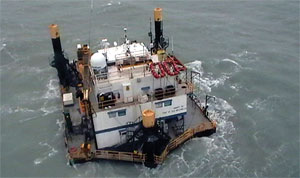 |
|
Associated Press/Mexican Navy |
|
The lift boat Trinity II lies disabled in the Gulf of Mexico one day after the crew’s evacuation that |
Four crewmen from a Louisiana-based lift boat were killed after they abandoned their damaged vessel via a small life float during a tropical storm in the southern Gulf of Mexico. Their inflatable life rafts had been lost overboard before the evacuation.
One of the stabilizing legs of the U.S.-flagged Trinity II buckled or snapped as heavy seas moved toward the Bay of Campeche off the coast of Mexico on Sept. 7 and 8, 2011. Ten occupants of Trinity II evacuated the swaying 94-foot lift boat at around 1200 on Sept. 8, said Geokinetics Inc., which had hired the vessel.
The entire group had been missing for three days when their life float was finally spotted by an oil-service vessel, the Mexican navy said. Four survivors were still with the float. Three other survivors, wearing life vests, were floating nearby. One of the dead men was tethered to the float, one body was found floating and one body wasn't found for about a week. One of the initial survivors later died in a hospital.
Two of the men killed were mariners with Trinity Liftboat Services of New Iberia, La. Another was an employee of Geokinetics, a seismic exploration company based in Houston. The fourth was a contract oil worker.
Geokinetics President and CEO Dick Miles said Trinity II was damaged in "high winds and unusually high seas." The crew abandoned ship just before the worst of the wind struck the bay.
"This was a strong and rapidly developing storm that resulted in unusual weather conditions at the time of the incident," Miles said.
Tropical Storm Nate entered the Bay of Campeche on Sept. 7. Shortly after the crew evacuated Trinity II on the following afternoon, wind speeds peaked at 70 mph. Wave heights soared to at least 10.5 feet, according to data from a National Oceanic and Atmospheric Administration weather buoy in the bay. Ten-foot waves persisted for another 24 hours after that.
Trinity II was operating in 25 feet of water about eight miles from the port of Frontera, Mexico. The last radio message from the Trinity II crew was the captain saying they were losing communications and evacuating. Other vessels were not able to come to their aid, including the project's nearby cable-laying ship Mermaid Vigilance, which retreated toward the coast.
"The Mermaid Vigilance, carrying a total of 30 crew and passengers, was caught in this storm and the master was forced to take evasive action to protect the personnel on board," Mermaid Marine Australia Ltd., owner of the 230-foot vessel, said in a statement.
A massive search followed, with vessels provided by the Mexican navy and aircraft hired by the oil company Pemex.
The storm washed the life float farther out to sea. It was finally spotted by the crew of the anchor handling tug supply vessel Bourbon Artabaze about 51 miles from the Mexican state of Campeche, more than 100 miles away from Trinity II.
Authorities did not specify the model of the life float. Petty Officer Elizabeth Bordelon, a U.S. Coast Guard spokeswoman, said it was a "rigid, rectangular-shaped float with a mesh-net bottom which is exposed to the water." She said the float could handle up to 12 people.
Francis Spagnoletti, an attorney representing multiple victims, said Trinity II had two 25-person life rafts, each stocked with food, water and communication devices. During attempted deployment, each was swept away.
"The canisters were popped but in the high winds they blew off" the lift boat, Spagnoletti said. "One, the wind just ripped it away. The second one, three people were trying to hold it with a rope, but it was cutting their hands. They were left with this old-fashioned raft. They were holding onto the outside of it. It's ridiculous."
Mexican officials and Pemex identified the dead Trinity employees as Nicholas Reed, 31, and Craig Joseph Myers, 32, both of New Iberia. Reed drowned and Myers died of dehydration-related shock. Reed was the son of Trinity's president, Randy Reed.
Geokinetics worker Kham Nadimuzzaman, of Bangladesh, died of dehydration-related shock in a hospital. Contract worker Aaron Houweling, 33, of Australia, had lost his grip on the raft early in the ordeal, and his body was found by the Mexican navy on Sept. 14, the navy said.
Surviving were two American mariners, including Trinity II's captain, and four Mexicans. They were treated in the hospital for severe dehydration, starvation and sunburn.
